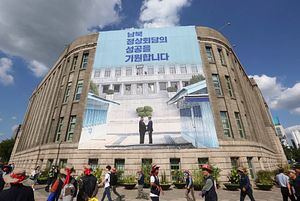In a press briefing following his September 5 visit to Pyongyang, South Korean Director of National Security Chung Eui-yong provided a clear indication of the degree of importance both South and North Korea attach to the September 18-20 inter-Korean summit. Chung announced that the summit will take place over three full days, indicative of the amount of work the two sides have identified for themselves and their allowance of plenty of time to consider and work through sticking points.
Chun then announced that the central focus of the summit would be to “examine… the outcome of the implementation of the Panmunjom Declaration and confirm how to push for the Declaration going forward.” This suggests that South and North Korea believe that the April 27 inter-Korean summit and its declaration played a critical role in prodding the United States into direct diplomatic talks with the North.
Following the abrupt cancellation last month of U.S Secretary of State Mike Pompeo’s planned visit to Pyongyang, it is likely that South and North Korea intend to make use of the September summit to reprise April and lead the United States back to the talks. The positive response by the White House to Chairman Kim’s letter to President Trump requesting another summit is evidence that the announcement of the new inter-Korean summit and its agenda has already had an intended positive effect on the U.S. receptiveness to more talks.
Chung’s statement that “The discussions at the summit will… be centered around issues on the permanent settlement of peace and common prosperity on the Korean Peninsula” corresponds to South Korean President Moon Jae-in’s formulation expressed in his recent national address that “advancement in inter-Korean relations is the driving force behind denuclearization of the Korean Peninsula.”
South and North Korea apparently believe that “advancement in inter-Korean peace and common prosperity” is the best way forward toward eventual denuclearization of the Korean Peninsula. The U.S. approach has been the reverse, as in “complete, verifiable, irreversible disarmament of North Korea” can eventually lead to peace and prosperity for North Korea.
So far the three parties when speaking publicly have soft-pedaled and sometimes denied these important divergences. Presumably, negotiators understand at least the basics of their differences and have begun discussing these in private meetings. At the moment no one knows when or if there will be real progress in reconciling the differences.
Significantly Chung reports that “Chairman Kim Jong Un reconfirmed his determination to completely denuclearize the Korean Peninsula and expressed his willingness for close cooperation not only with the South but also with the United States in that regard.” Chung also promised the summit will discuss “practical measures to realize denuclearization on the Peninsula.”
This is the most challenging agenda item at the summit. It is an opportunity for North and South Korea to bring forward some ideas and proposals for overcoming the differences in meaning attributed to the phrase “denuclearizing the peninsula.” While it is hard to imagine many practical measures happening at this early stage of rapprochement, symbolic actions remain very possible.
One of the results of this summit might be a revised and updated version of the 1992 Joint Declaration of the Denuclearization of the Korean Peninsula. This would contribute to the process of clarifying what the two Koreas mean by “Denuclearization of the Korean Peninsula.”
Among the items with strong symbolism and political import that could come from this summit is a plan to sign a joint statement to end the Korean War. Trump might be induced by that inter-Korean action to negotiate his own joint statement of peace with North Korea. Among the reciprocal moves that North Korea could take to help move negotiations forward at that point would be a unilateral suspension of further production of fissionable materials, as proposed by Morton Halperin. As with the suspension of testing, this gesture would not undermine the credibility of North Korea’s present nuclear deterrent.
What will almost surely not come out of this summit are some items that leaders and analysts in the United States have called on North Korea to provide. These include a detailed roadmap and timetable for disarmament and an inventory of nuclear weapons and associated production and storage sites. Expecting these steps is premature by years in any realistic road to disarmament. No newly nuclear-armed nation with profound security concerns would ever provide a comprehensive list of their nuclear assets and their location to their real or potential enemies, which can then use it for targeting and contingency planning. As a mostly symbolic gesture, the North Koreans might offer a list of items they believe the United States already knows about. Of course, the substantive value for disarmament purposes of that partial inventory would be rather small.
Finally, it will be a positive sign if the two Koreas come out of this summit with some particulars on how they will, in Chung’s words, “ease military tensions and [make] concrete plans to establish mutual trust.” Denuclearization, if it occurs, is a long-term project. It will not happen in the case of Korea unless there are very substantial reductions and redeployments of conventional weaponry and military units on the peninsula. Just think of North Korea’s long-time substitute for nuclear weapons, its thousands of artillery pieces dug in and aimed toward Seoul. And these days South Korea has hundreds of conventionally-armed rockets aimed at key facilities in the North. All of this has to change, in a step-by-step reciprocal and verified process as trust builds. This is the hard part of making peace. It takes time and persistent will.
Charles Knight is a Senior Fellow at the Center for International Policy, Washington DC, New York, NY, and Cambridge, MA.
































